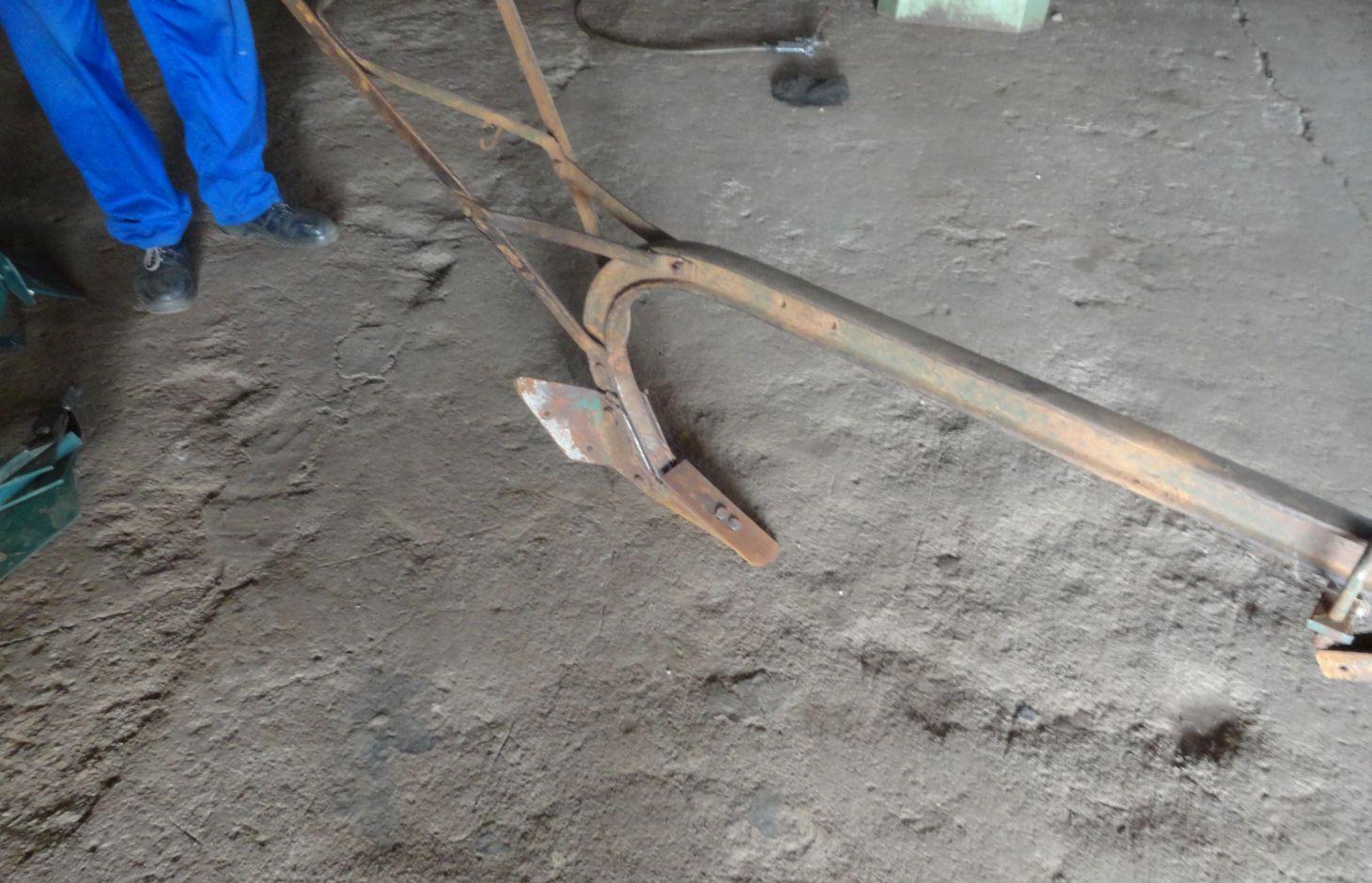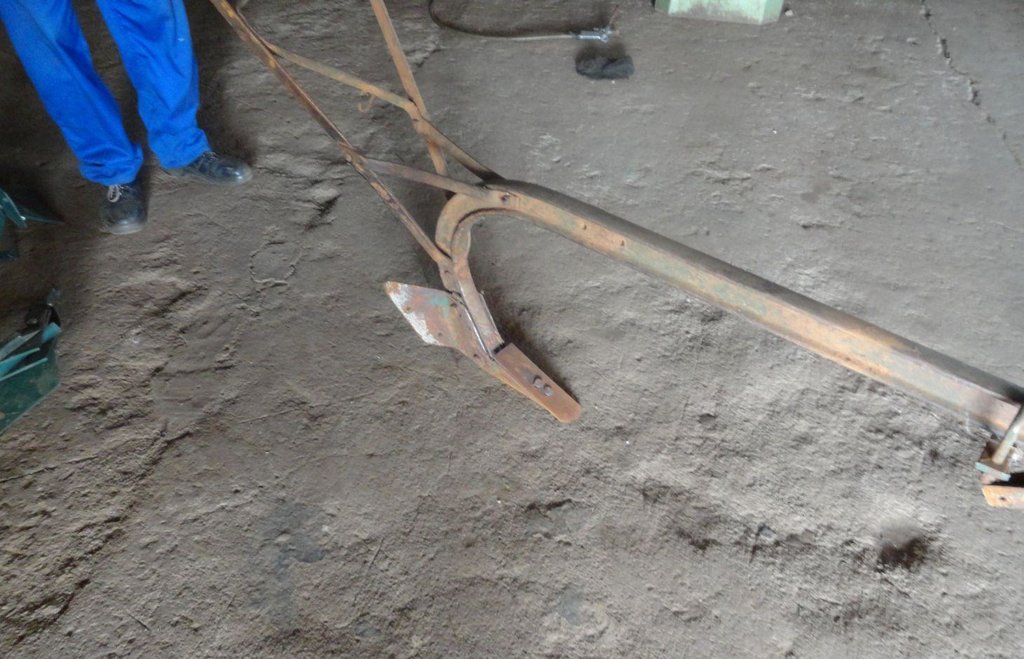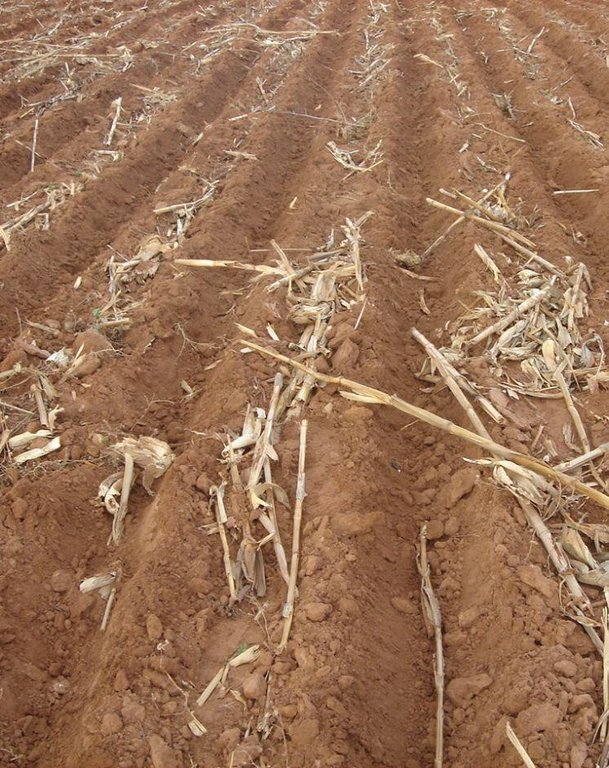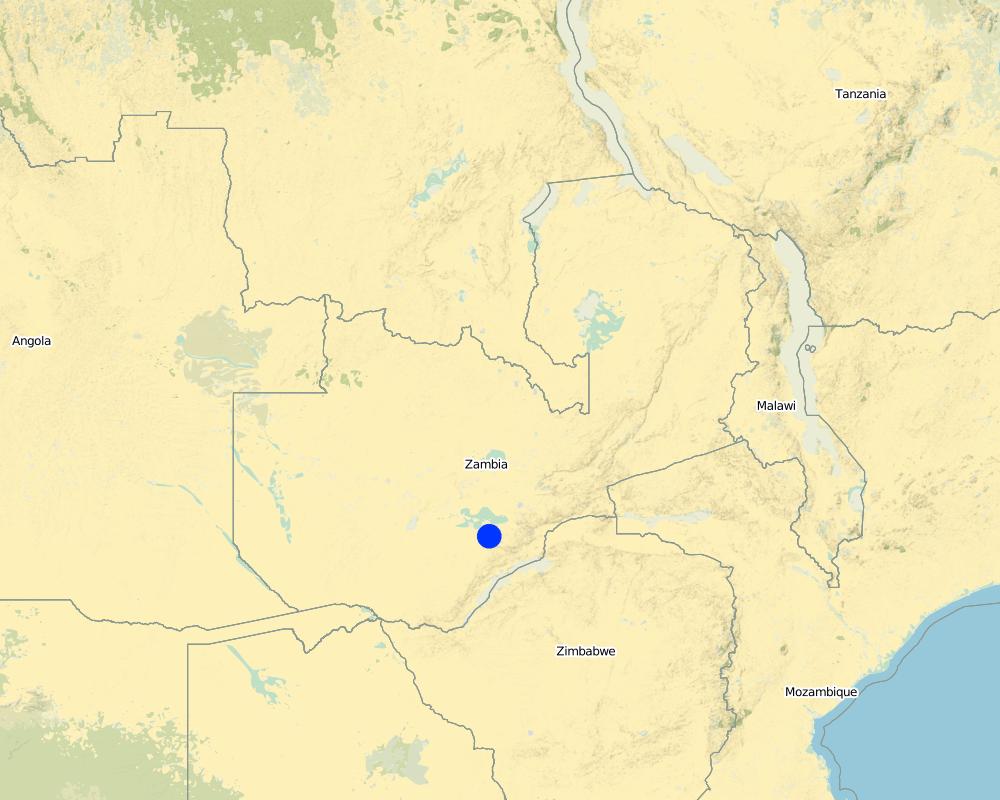Conservation Tillage with Magoye Ripper [Zambie]
- Création :
- Mise à jour :
- Compilateur : Silenga Wamunyima
- Rédacteur : –
- Examinateur : Fabian Ottiger
Minimum tillage
technologies_1139 - Zambie
Voir les sections
Développer tout Réduire tout1. Informations générales
1.2 Coordonnées des personnes-ressources et des institutions impliquées dans l'évaluation et la documentation de la Technologie
Spécialiste GDT:
Spécialiste GDT:
Katoweji Alfred
(+260) 211 213 739
Golden Valley Agricultural Research Trust
PO. Box 50834 Lusaka
Zambie
Spécialiste GDT:
Ndandula Sharon
(+260) 211 213 739
Golden Valley Agricultural Research Trust
PO. Box 50834 Lusaka
Zambie
Nom du ou des institutions qui ont facilité la documentation/ l'évaluation de la Technologie (si pertinent)
Golden Valley agricultural research trust (Golden Valley agricultural research trust) - Zambie1.3 Conditions relatives à l'utilisation par WOCAT des données documentées
Quand les données ont-elles été compilées (sur le terrain)?
15/01/2013
Le compilateur et la(les) personne(s) ressource(s) acceptent les conditions relatives à l'utilisation par WOCAT des données documentées:
Oui
1.5 Référence au(x) questionnaire(s) sur les Approches de GDT
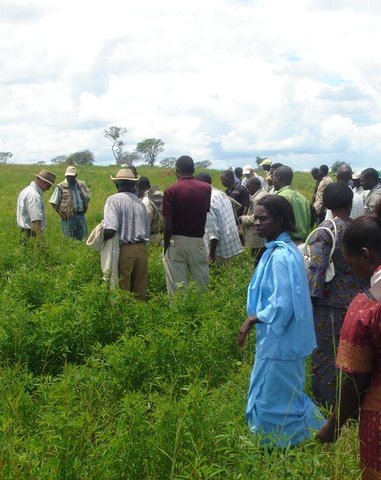
Participatory Research and Development [Zambie]
This is a collaborative process between researchers and farmers for developing and adapting new technologies that focus on incorporating the perspectives and inputs from the farmers into the development process.
- Compilateur : Arthur Chomba
2. Description de la Technologie de GDT
2.1 Courte description de la Technologie
Définition de la Technologie:
Conservation Tillage with the Magoye Ripper is an animal draft reduced tillage method that involves the use of the Magoye Ripper to loosen the soil by shattering with a tine instead of ploughing.
2.2 Description détaillée de la Technologie
Description:
The Magoye Ripper is an animal drawn implement used for conservation tillage. The Ripper consists of a frame that is attached to a common plough beam and on this frame is fixed a tine at an angle that penetrates and breaks up the soil when pulled. Only the region where the crop furrow will be is loosened by the tine and by so doing reducing the amount of tillage and disruption of soil structure while preserving the crop residue cover. The frame has some ‘wings’ attached to it that throw the soil out of the ripped furrow to leave it open for planting and collecting of water. Ripping is done in one pass up to a depth of 15cm depending on the strength of the oxen, soil type, hitch assembly settings and the sharpness of the tine.
Purpose of the Technology: Reducing tillage first of all reduces tillage costs and tillage time allowing more time for the farmer to plant early and/or a bigger area. Reducing tillage also reduces the loss of soil organic matter and the destructive effects to the soil structure ultimately improving soil fertility and soil water conservation. Ripping does not invert the soil, hence it does not bury crop residues which further enhance organic matter levels and protect the soil from excessive evaporation and erosion. The open furrow left by the ripper collects water from the adjacent untilled soil much in the same way basins (zai system) are used for water harvesting. This together with the increased rooting depth resulting from the breaking of compacted soil, enhanced infiltration and early planting improves water conservation and hence the resilience of crop to extended dry spells.
Establishment / maintenance activities and inputs: The establishment of ripping based conservation tillage mainly involves the purchase of the ripper frame and the
replaceable tines. Liming acidic soils (low pH soils) followed by a final ploughing will be required to correct the soil pH which otherwise will be difficult to correct once conservation tillage has been established. The main establishment activity involves adopting a new mindset and increasing the knowledge base to apply the technology correctly. Knowledge about alternative weed control practices and herbicide use is particularly cardinal as the farmer will have to adopt new weeding practices and routines in the absence of ploughing. Maintenance activities are more or less the same as conventional tillage except for replacing the tillage tines which wear every now and then. The same applies for the inputs except for the increase in use of herbicides.
Natural / human environment: Ripping is best performed in dry season when the soil is dry although this may not be possible with some of the smaller and/or weak oxen when the soil is too dry. It is therefore recommended for farmers in regions that experience long dry seasons to rip at the end of harvest before the soils get too dry and hard and when the oxen are in good condition before they lose weight and strength due to less feed and water, excessive heat as the dry season progresses.
The ripper is mostly suited to small-scale farmers just adopting Conservation Agriculture (CA) since the tool can be easily adapted to the existing plough beam which most of the farmers already have. The small capital outlay for establishing the system makes it suited to resource poor and risk-averse farmers.
2.3 Photos de la Technologie
2.5 Pays/ région/ lieux où la Technologie a été appliquée et qui sont couverts par cette évaluation
Pays:
Zambie
Région/ Etat/ Province:
Zambia/Southern Province
Autres spécifications du lieu:
Mazabuka/Magoye
Map
×2.6 Date de mise en œuvre de la Technologie
Si l'année précise est inconnue, indiquez la date approximative: :
- il y a entre 10-50 ans
2.7 Introduction de la Technologie
Spécifiez comment la Technologie a été introduite: :
- au cours d'expérimentations / de recherches
Commentaires (type de projet, etc.) :
The Magoye Ripper was introduced in 1995 after a period of adaptive research by government research branch under a project supported by the Netherlands government.
3. Classification de la Technologie de GDT
3.1 Principal(aux) objectif(s) de la Technologie
- réduire, prévenir, restaurer les terres dégradées
3.2 Type(s) actuel(s) d'utilisation des terres, là où la Technologie est appliquée

Terres cultivées
- Cultures annuelles
Principales cultures (vivrières et commerciales):
Major cash crop: Cotton, maize
Major food crop: Maize
Major other crops: Groundnuts

Mixte (cultures/ pâturages/ arbres), incluant l'agroforesterie
- Agro-pastoralisme
Principaux produits/ services:
Main species seminomadism/pastoralism: Cattle, goats, pigs
Commentaires:
Major land use problems (compiler’s opinion): Loss of soil structure and loss of soil fertility
Major land use problems (land users’ perception): Droughts and dry dpells
Livestock is grazing on crop residues
3.3 Informations complémentaires sur l'utilisation des terres
Approvisionnement en eau des terres sur lesquelles est appliquée la Technologie:
- pluvial
Nombre de période de croissance par an: :
- 1
Précisez:
Longest growing period in days: 135 Longest growing period from month to month: Mid November to end of March
Densité d'élevage/ chargement (si pertinent):
1-10 LU /km2
3.4 Groupe de GDT auquel appartient la Technologie
- perturbation minimale du sol
3.5 Diffusion de la Technologie
Spécifiez la diffusion de la Technologie:
- répartie uniformément sur une zone
Si la Technologie est uniformément répartie sur une zone, indiquez la superficie couverte approximative:
- 0,1-1 km2
Commentaires:
250 rippers were distributed in Magoye and surveys show that only about half of these farmers continued to use the ripper. The field sizes range from 1/4ha to 1/2ha.
3.6 Mesures de GDT constituant la Technologie

pratiques agronomiques
- A2: Matière organique/ fertilité du sol
- A6: Autres
Commentaires:
Main measures: agronomic measures
Specification of other agronomic measures: Reduced Tillage, Crop Residues
Type of agronomic measures: early planting, mulching, manure / compost / residues, mineral (inorganic) fertilizers, soil conditioners (lime, gypsum), rotations / fallows, breaking compacted topsoil, minimum tillage, non-inversion tillage, furrows (drainage, irrigation), breaking compacted subsoil
3.7 Principaux types de dégradation des terres traités par la Technologie

érosion hydrique des sols
- Wt: perte de la couche superficielle des sols (couche arable)/ érosion de surface

dégradation chimique des sols
- Cn: baisse de la fertilité des sols et réduction du niveau de matière organique (non causée par l’érosion)

dégradation physique des sols
- Pc: compaction

dégradation biologique
- Bl: perte de la vie des sols
Commentaires:
Main type of degradation addressed: Cn: fertility decline and reduced organic matter content, Pc: compaction, Bl: loss of soil life
Secondary types of degradation addressed: Wt: loss of topsoil / surface erosion
Main causes of degradation: soil management (Over-ploughing), crop management (annual, perennial, tree/shrub) (Monocropping), overgrazing (Crop residues overgrazed leaving land exposed), poverty / wealth (under application of fertilizer leading to nutrient mining, charcoal burning)
Secondary causes of degradation: deforestation / removal of natural vegetation (incl. forest fires) (Charcoal burning), Heavy / extreme rainfall (intensity/amounts) (high intensity storms leading to erosion), droughts (resulting in inadequate soil cover), land tenure (communal land over-exploited), governance / institutional (lack of credit facilities)
3.8 Prévention, réduction de la dégradation ou réhabilitation des terres dégradées
Spécifiez l'objectif de la Technologie au regard de la dégradation des terres:
- réduire la dégradation des terres
Commentaires:
Secondary goals: prevention of land degradation, rehabilitation / reclamation of denuded land
4. Spécifications techniques, activités, intrants et coûts de mise en œuvre
4.1 Dessin technique de la Technologie
Auteur:
Silenga Wamunyima, Box 670577, Mazabuka, Zambia
4.2 Spécification/ explications techniques du dessin technique
Planting rip lines are done at a depth of 15-20 cm with inter row of 75 or 90 cm, 30-40 cm depth of the furrow of ripping can be achieved. This is achieved by running the ripper through the same rip line twice so that the tine gets deeper into the soil. The width of the open furrow is 10-15 cm wide. Ripping is done across the slope to reduce runoff. Ripping is best performed and recommended done in the dry season.
Location: Magoye. Mazabuka/Southern Province/Zambia
Date: 2014-06-29
Technical knowledge required for field staff / advisors: high (The use of the Ripper itself is simple but applying it as part of a conservation agriculture system can be knowledge demanding.)
Technical knowledge required for land users: moderate (adapting the production system to accommodate the Ripper will require learning new practices for weeding, planting and fertility management.)
Main technical functions: improvement of ground cover, improvement of topsoil structure (compaction), improvement of subsoil structure (hardpan), increase of infiltration, water harvesting / increase water supply
Secondary technical functions: control of raindrop splash, improvement of surface structure (crusting, sealing), increase in organic matter, increase in nutrient availability (supply, recycling,…), increase / maintain water stored in soil, increase of groundwater level / recharge of groundwater
Early planting
Material/ species: maize, cotton
Quantity/ density: 44,000 pla
Remarks: 25cm intra row by 75cm
Mulching
Material/ species: crop residues
Quantity/ density: 3ton/ha
Remarks: uniformly spread
Manure / compost / residues
Material/ species: residues
Quantity/ density: 3ton/ha
Remarks: uniformly spread
Mineral (inorganic) fertilizers
Material/ species: Basal and top dressing
Quantity/ density: 400kg/ha
Remarks: spot application
Soil conditioners (lime, gypsum)
Material/ species: lime
Quantity/ density: 1ton/ha
Rotations / fallows
Material/ species: maize in rotation with cotton, groundnuts and cowpeas
Breaking compacted topsoil
Material/ species: Ripping with Magoye Ripper at 15cm depth
Remarks: 75cm or 90cm row spacing
Minimum tillage
Material/ species: ripping
Non-inversion tillage
Material/ species: ripping
Furrows (drainage, irrigation)
Material/ species: ripped lines leave furrows for water harvesting
Breaking compacted subsoil
Material/ species: deep ripping at 20cm
4.3 Informations générales sur le calcul des intrants et des coûts
autre/ monnaie nationale (précisez):
Kwacha
Indiquer le taux de change du dollars en monnaie locale (si pertinent): 1 USD= :
5,0
Indiquez le coût salarial moyen de la main d'œuvre par jour:
2.40
4.4 Activités de mise en place/ d'établissement
| Activité | Type de mesures | Calendrier | |
|---|---|---|---|
| 1. | Purchase magoye ripper | Agronomique | |
| 2. | Purchase knapsack sprayer | Agronomique |
Commentaires:
Lifespan of the magoye ripper: 7 years
Lifespan of the Knapsack sprayer: 5 years
4.5 Coûts et intrants nécessaires à la mise en place
| Spécifiez les intrants | Unité | Quantité | Coûts par unité | Coût total par intrant | % des coût supporté par les exploitants des terres | |
|---|---|---|---|---|---|---|
| Equipements | Magoye ripper | Tool | 1,0 | 50,0 | 50,0 | 100,0 |
| Equipements | Knapsack sprayer | Tool | 1,0 | 80,0 | 80,0 | 100,0 |
| Coût total de mise en place de la Technologie | 130,0 | |||||
Commentaires:
Duration of establishment phase: 5 month(s)
4.6 Activités d'entretien/ récurrentes
| Activité | Type de mesures | Calendrier/ fréquence | |
|---|---|---|---|
| 1. | slashing and spreading residues | Agronomique | May-June yearly after harvest |
| 2. | Ripping | Agronomique | May-June after harvest |
| 3. | Liming | Agronomique | Nov-Dec before planting |
| 4. | Planting and fertilizing | Agronomique | Nov-Dec at onset of rains |
| 5. | chemical weeding | Agronomique | 3 times |
| 6. | harvesting | Agronomique | April-May |
4.7 Coûts et intrants nécessaires aux activités d'entretien/ récurrentes (par an)
| Spécifiez les intrants | Unité | Quantité | Coûts par unité | Coût total par intrant | % des coût supporté par les exploitants des terres | |
|---|---|---|---|---|---|---|
| Main d'œuvre | Slashing and spreading residues | ha | 1,0 | 20,0 | 20,0 | 100,0 |
| Main d'œuvre | Ripping | ha | 1,0 | 50,0 | 50,0 | 100,0 |
| Main d'œuvre | Liming | ha | 1,0 | 42,0 | 42,0 | 100,0 |
| Main d'œuvre | Planting and fertilizing | ha | 1,0 | 40,0 | 40,0 | 100,0 |
| Matériel végétal | Seeds | kg | 20,0 | 2,5 | 50,0 | 100,0 |
| Engrais et biocides | Fertilizer | kg | 400,0 | 0,8 | 320,0 | 100,0 |
| Autre | Herbicides | liters | 5,0 | 6,0 | 30,0 | 100,0 |
| Autre | Labour: Chemical weeding | ha | 1,0 | 24,0 | 24,0 | 100,0 |
| Autre | Labour: Harvesting | ha | 1,0 | 20,0 | 20,0 | 100,0 |
| Coût total d'entretien de la Technologie | 596,0 | |||||
Commentaires:
Machinery/ tools: Magoye Ripper
Calculation are for a 1ha of maize under magoye ripper based conservation tillage and costs are for the Zambia situation in Magoye as of August 2012.
4.8 Facteurs les plus importants affectant les coûts
Décrivez les facteurs les plus importants affectant les coûts :
The weed control method employed is the main determinate factor depending on whether the farmer uses hand hoe or herbicides. Abandoning ploughing leads to higher weed densities leading to increased labour requirements/recurrent costs if hand weeding is used. However, with herbicides the weeding labour demand and costs cost are much lower by a factor of about 5. Another major cost is that of fertilizer which makes up about half the cost hence the total cost will vary significantly depending on fertilizer cost.
5. Environnement naturel et humain
5.1 Climat
Précipitations annuelles
- < 250 mm
- 251-500 mm
- 501-750 mm
- 751-1000 mm
- 1001-1500 mm
- 1501-2000 mm
- 2001-3000 mm
- 3001-4000 mm
- > 4000 mm
Spécifications/ commentaires sur les précipitations:
Average rainfall 700mm, summer rains from November to March.
Zone agro-climatique
- semi-aride
Thermal climate class: subtropics. 3 distinct seasons – summer, winter and one rainy season
5.2 Topographie
Pentes moyennes:
- plat (0-2 %)
- faible (3-5%)
- modéré (6-10%)
- onduleux (11-15%)
- vallonné (16-30%)
- raide (31-60%)
- très raide (>60%)
Reliefs:
- plateaux/ plaines
- crêtes
- flancs/ pentes de montagne
- flancs/ pentes de colline
- piémonts/ glacis (bas de pente)
- fonds de vallée/bas-fonds
Zones altitudinales:
- 0-100 m
- 101-500 m
- 501-1000 m
- 1001-1500 m
- 1501-2000 m
- 2001-2500 m
- 2501-3000 m
- 3001-4000 m
- > 4000 m
Commentaires et précisions supplémentaires sur la topographie:
Slopes on average: Also flat and moderate (classed 2) and rolling (classed 3)
5.3 Sols
Profondeur moyenne du sol:
- très superficiel (0-20 cm)
- superficiel (21-50 cm)
- modérément profond (51-80 cm)
- profond (81-120 cm)
- très profond (>120 cm)
Texture du sol (de la couche arable):
- moyen (limoneux)
- fin/ lourd (argile)
Matière organique de la couche arable:
- moyen (1-3%)
- faible (<1%)
Si disponible, joignez une description complète du sol ou précisez les informations disponibles, par ex., type de sol, pH/ acidité du sol, capacité d'échange cationique, azote, salinité, etc.
Soil fertility: Low (classed 1) and medium (classed 2, low fertility caused mainly by poor soil management practices, otherwise soil are inherently fertile)
Topsoil organic matter: Low (classed 1) and medium (classed 2, due to excessive ploughing and nutrient mining)
Soil drainage/infiltration: Good (classed 1, soils naturally are well drained except were soil have bee compacted by poor management practices) and medium (classed 2)
Soil water storage capacity: Medium (classed 1, soils mostly loam to sandy loam with medium storage capacity) and low (ranked 2)
5.4 Disponibilité et qualité de l'eau
Profondeur estimée de l’eau dans le sol:
> 50 m
Disponibilité de l’eau de surface:
moyenne
Qualité de l’eau (non traitée):
eau potable
Commentaires et précisions supplémentaires sur la qualité et la quantité d'eau:
Ground water table: <50m (ranked 1, hand wells are <20m but reliable boreholes are > 50m) and 5-50m (ranked 2)
Availability of surface water: Medium (mostly seasonal streams and dams)
Water quality (untreated): Good drinking water (ranked 1, from hand pumps (both communal and private)) and poor drinking water (treatment required, from hand dug wells, ranked 1 also)
5.5 Biodiversité
Diversité des espèces:
- moyenne
Commentaires et précisions supplémentaires sur la biodiversité:
Human population densities are relatively low
5.6 Caractéristiques des exploitants des terres appliquant la Technologie
Revenus hors exploitation:
- 10-50% de tous les revenus
Niveau relatif de richesse:
- très pauvre
- pauvre
Individus ou groupes:
- individu/ ménage
Genre:
- hommes
Indiquez toute autre caractéristique pertinente des exploitants des terres:
Land users applying the Technology are mainly common / average land users
Difference in the involvement of women and men: The technology is applied mostly by men since most households are male headed and animal traction operation are reserved for men. Planting and weeding operations are the domain of women and children
Population density: 10-50 persons/km2
Annual population growth: 3% - 4%
8% of the land users are rich and own 15% of the land (own more than 10 cattle).
8% of the land users are average wealthy and own 15% of the land (own between 5 and 10 cattle).
16% of the land users are poor and own 20% of the land (own less than 5).
68% of the land users are poor and own 40% of the land (do not own cattle).
Off-farm income specification: sale of rainfed crops makes up about half of their income, the remainder coming from sale of livestock, petty trading, hiring out labour and remittances
Market orientation of production system: Mixed (subsistence/ commercial, sale of excess maize and cotton, dairy, ranked 1) and subsistence (self-supply, livestock, maize and legumes for home consumption, ranked 2),
Level of mechanization: Animal traction (ranked 1, families without cattle borrow or hire), mechanised (ranked 2) and manual labour (ranked 2, only for small backyard fields)
5.7 Superficie moyenne des terres détenues ou louées par les exploitants appliquant la Technologie
- < 0,5 ha
- 0,5-1 ha
- 1-2 ha
- 2-5 ha
- 5-15 ha
- 15-50 ha
- 50-100 ha
- 100-500 ha
- 500-1 000 ha
- 1 000-10 000 ha
- > 10 000 ha
Cette superficie est-elle considérée comme de petite, moyenne ou grande dimension (en se référant au contexte local)?
- petite dimension
Commentaires:
Average area of land owned or leased by land users applying the Technology: Also: 5-15 ha, 15-50 ha, 50-100 ha
5.8 Propriété foncière, droits d’utilisation des terres et de l'eau
Propriété foncière:
- individu, sans titre de propriété
Droits d’utilisation des terres:
- accès libre (non organisé)
- individuel
- Land is apportioned by traditional leaders
Droits d’utilisation de l’eau:
- accès libre (non organisé)
- Land is apportioned by traditional leaders
5.9 Accès aux services et aux infrastructures
santé:
- pauvre
- modéré
- bonne
éducation:
- pauvre
- modéré
- bonne
assistance technique:
- pauvre
- modéré
- bonne
emploi (par ex. hors exploitation):
- pauvre
- modéré
- bonne
marchés:
- pauvre
- modéré
- bonne
énergie:
- pauvre
- modéré
- bonne
routes et transports:
- pauvre
- modéré
- bonne
eau potable et assainissement:
- pauvre
- modéré
- bonne
services financiers:
- pauvre
- modéré
- bonne
6. Impacts et conclusions
6.1 Impacts sur site que la Technologie a montrés
Impacts socio-économiques
Production
production agricole
Quantité avant la GDT:
1.8ton/ha
Quantité après la GDT:
2ton/ha
Commentaires/ spécifiez:
mostly due to early planting
production fourragère
Commentaires/ spécifiez:
crop residues needed for soil cover
risque d'échec de la production
Commentaires/ spécifiez:
Better tolerance to dry spells
surface de production
Quantité après la GDT:
20%
Revenus et coûts
dépenses pour les intrants agricoles
Commentaires/ spécifiez:
purchase of herbicides
revenus agricoles
Quantité après la GDT:
15%
Commentaires/ spécifiez:
due to lower tillage cost, better yield
charge de travail
Commentaires/ spécifiez:
only if herbicicdes are used for weeding
Impacts socioculturels
sécurité alimentaire/ autosuffisance
Commentaires/ spécifiez:
due to improved yields and more time and labour to diversify
possibilités de loisirs
Commentaires/ spécifiez:
Less time spent preparing land
apaisement des conflits
Commentaires/ spécifiez:
competition for crop residues with neighbours cattle
Improved livelihoods and human well-being
Commentaires/ spécifiez:
Technology not yet been applied on a large enough area to make significant impact at community level but increased farm incomes among farmers has led to better education and health among household members.
Impacts écologiques
Cycle de l'eau/ ruissellement
qualité de l'eau
Commentaires/ spécifiez:
due to improved good drainage
récolte/ collecte de l'eau
Commentaires/ spécifiez:
open furows collect water
ruissellement de surface
Commentaires/ spécifiez:
due to better soil cover
drainage de l'excès d'eau
Commentaires/ spécifiez:
due to improved soil structure
nappes phréatiques/ aquifères
Commentaires/ spécifiez:
not applied extensively
évaporation
Commentaires/ spécifiez:
due to better soil cover
Sols
humidité du sol
Commentaires/ spécifiez:
due to resulting improved soil srtucture
couverture du sol
Commentaires/ spécifiez:
Due to non-inversion tillage
perte en sol
Commentaires/ spécifiez:
Due to less soil disturbance and better soil cover
encroûtement/ battance du sol
Commentaires/ spécifiez:
Due to less soil disturbance
compaction du sol
Commentaires/ spécifiez:
Due to less soil disturbance
cycle/ recharge des éléments nutritifs
Commentaires/ spécifiez:
Due to less soil disturbance
salinité
Commentaires/ spécifiez:
due to resulting good drainage
matière organique du sol/ au dessous du sol C
Commentaires/ spécifiez:
Due to less soil disturbance
Biodiversité: végétale, animale
biomasse/ au dessus du sol C
Commentaires/ spécifiez:
Due to less soil disturbance
diversité animale
Commentaires/ spécifiez:
due to increased soil organic matter (SOM)
Autres impacts écologiques
Waterlogging
Commentaires/ spécifiez:
Open furrow collect water in times of excess rainfal
Soil erosion locally
Commentaires/ spécifiez:
If furrow are made along the slope
6.2 Impacts hors site que la Technologie a montrés
disponibilité de l'eau
Commentaires/ spécifiez:
only if applied on a large scale
flux des cours d'eau fiables et stables en saison sèche
Commentaires/ spécifiez:
only if applied on a large scale
inondations en aval
Commentaires/ spécifiez:
only if applied on a large scale
envasement en aval
Commentaires/ spécifiez:
only if applied on a large scale
pollution des rivières/ nappes phréatiques
Commentaires/ spécifiez:
only if applied on a large scale
dommages sur les champs voisins
Commentaires/ spécifiez:
only if applied on a large scale
6.3 Exposition et sensibilité de la Technologie aux changements progressifs et aux évènements extrêmes/catastrophes liés au climat (telles que perçues par les exploitants des terres)
Changements climatiques progressifs
Changements climatiques progressifs
| Saison | Type de changements/ extrêmes climatiques | Comment la Technologie fait-elle face à cela? | |
|---|---|---|---|
| températures annuelles | augmente | pas connu |
Extrêmes climatiques (catastrophes)
Catastrophes météorologiques
| Comment la Technologie fait-elle face à cela? | |
|---|---|
| pluie torrentielle locale | pas bien |
| tempête de vent locale | pas connu |
Catastrophes climatiques
| Comment la Technologie fait-elle face à cela? | |
|---|---|
| sécheresse | bien |
Catastrophes hydrologiques
| Comment la Technologie fait-elle face à cela? | |
|---|---|
| inondation générale (rivière) | pas bien |
Autres conséquences liées au climat
Autres conséquences liées au climat
| Comment la Technologie fait-elle face à cela? | |
|---|---|
| réduction de la période de croissance | bien |
Commentaires:
Magoye ripper based conservation tillage should be applied in well drained fields to avoid water-logging in the ripped furrows during seasons of excess rainfall or events of heavy downpours.
6.4 Analyse coûts-bénéfices
Quels sont les bénéfices comparativement aux coûts de mise en place (du point de vue des exploitants des terres)?
Rentabilité à court terme:
positive
Rentabilité à long terme:
très positive
Quels sont les bénéfices comparativement aux coûts d'entretien récurrents (du point de vue des exploitants des terres)?
Rentabilité à court terme:
positive
Rentabilité à long terme:
très positive
Commentaires:
Timely planting enables larger areas to be planted and better yields. In the long term, improved soil fertility and soil structure results in sustained improved yields. However, if herbicides are not used, the costs and labour requirements of weeding can result in negative benefits.
6.5 Adoption de la Technologie
Commentaires:
250 land user families have adopted the Technology with external material support
Comments on acceptance with external material support: The farmers bought the Magoye Rippers at half price and over half of them abandoned the technology after the first or second year of use.
Comments on spontaneous adoption: Information on spontaneous adoption is not documented although there have been reports of this in other districts.
There is a little trend towards spontaneous adoption of the Technology
Comments on adoption trend: Availability of replacement tines and the increased weed challenge have been a major hindrances to widespread adoption.
6.7 Points forts/ avantages/ possibilités de la Technologie
| Points forts/ avantages/ possibilités du point de vue de l'exploitant des terres |
|---|
|
Enables early planting How can they be sustained / enhanced? planting with the first heavy rainfall in November |
| Points forts/ avantages/ possibilités du point de vue du compilateur ou d'une autre personne ressource clé |
|---|
|
necessitates early planting How can they be sustained / enhanced? Plant in November or early December with the onset of rainfall |
|
fewer operations hence lower costs How can they be sustained / enhanced? continuous emphasis on early land preparation (May to July/August) |
|
conserves water and soil How can they be sustained / enhanced? encourage crop diversification and crop rotation legumes |
6.8 Faiblesses/ inconvénients/ risques de la Technologie et moyens de les surmonter
| Faiblesses/ inconvénients/ risques du point de vue de l’exploitant des terres | Comment peuvent-ils être surmontés? |
|---|---|
| weeding is difficult when herbicides are not used | train land users on how to use herbicides |
| ripping is hardly attained in heavy soils in October | rip between May and July |
| Faiblesses/ inconvénients/ risques du point de vue du compilateur ou d'une autre personne ressource clé | Comment peuvent-ils être surmontés? |
|---|---|
| weed pressure | encourage land users to use herbicides and continuous weeding |
7. Références et liens
7.2 Références des publications disponibles
Titre, auteur, année, ISBN:
Impact study on the acceptance of the Magoye Ripper, Piet Stevens, David Samazaka, Ab Wanders, Douglas Moono, 2002
Disponible à partir d'où? Coût?
GART/free
Titre, auteur, année, ISBN:
Social-economic analysis of conservation agriculture in southern Africa, FAO, 2011
Disponible à partir d'où? Coût?
FAO/free online
Titre, auteur, année, ISBN:
Conservation farming in Zambia, Steven Haggblade, Gelson Tembo, October 2003
Disponible à partir d'où? Coût?
INDABA Project, Michigan State University/free online.
Titre, auteur, année, ISBN:
Conservation farming in Zambia, Conservation farming unit (CFU), 2011
Disponible à partir d'où? Coût?
cfu@zamnet.zm
Liens et modules
Développer tout Réduire toutLiens

Participatory Research and Development [Zambie]
This is a collaborative process between researchers and farmers for developing and adapting new technologies that focus on incorporating the perspectives and inputs from the farmers into the development process.
- Compilateur : Arthur Chomba
Modules
Aucun module trouvé


